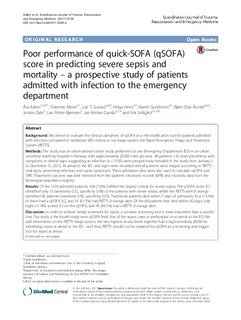| dc.contributor.author | Askim, Åsa Susanne | |
| dc.contributor.author | Moser, Florentin | |
| dc.contributor.author | Gustad, Lise | |
| dc.contributor.author | Stene, Helga | |
| dc.contributor.author | Gundersen, Maren | |
| dc.contributor.author | Åsvold, Bjørn Olav | |
| dc.contributor.author | Dale, Jostein | |
| dc.contributor.author | Bjørnsen, Lars Petter Bache-Wiig | |
| dc.contributor.author | Damås, Jan Kristian | |
| dc.contributor.author | Solligård, Erik | |
| dc.date.accessioned | 2017-10-26T12:52:23Z | |
| dc.date.available | 2017-10-26T12:52:23Z | |
| dc.date.created | 2017-06-13T09:09:00Z | |
| dc.date.issued | 2017 | |
| dc.identifier.issn | 1757-7241 | |
| dc.identifier.uri | http://hdl.handle.net/11250/2462397 | |
| dc.description.abstract | Background
We aimed to evaluate the clinical usefulness of qSOFA as a risk stratification tool for patients admitted with infection compared to traditional SIRS criteria or our triage system; the Rapid Emergency Triage and Treatment System (RETTS).
Methods
The study was an observational cohort study performed at one Emergency Department (ED) in an urban university teaching hospital in Norway, with approximately 20,000 visits per year. All patients >16 years presenting with symptoms or clinical signs suggesting an infection (n = 1535) were prospectively included in the study from January 1 to December 31, 2012. At arrival in the ED, vital signs were recorded and all patients were triaged according to RETTS vital signs, presenting infection, and sepsis symptoms. These admission data were also used to calculate qSOFA and SIRS. Treatment outcome was later retrieved from the patients’ electronic records (EPR) and mortality data from the Norwegian population registry.
Results
Of the 1535 admitted patients, 108 (7.0%) fulfilled the Sepsis2 criteria for severe sepsis. The qSOFA score ≥2 identified only 33 (sensitivity 0.32, specificity 0.98) of the patients with severe sepsis, whilst the RETTS-alert ≥ orange identified 92 patients (sensitivity 0.85, specificity 0.55). Twenty-six patients died within 7 days of admission; four (15.4%) of them had a qSOFA ≥2, and 16 (61.5%) had RETTS ≥ orange alert. Of the 68 patients that died within 30 days, only eight (11.9%) scored ≥2 on the qSOFA, and 45 (66.1%) had a RETTS ≥ orange alert.
Discussion
In order to achieve timely treatment for sepsis, a sensitive screening tool is more important than a specific one. Our study is the fourth study were qSOFA finds few of the sepsis cases in prehospital or at arrival to the ED. We add information on the RETTS triage system, the two highest acuity levels together had a high sensitivity (85%) for identifying sepsis at arrival to the ED - and thus, RETTS should not be replaced by qSOFA as a screening and trigger tool for sepsis at arrival.
Conclusion
In this observational cohort study, qSOFA failed to identify two thirds of the patients admitted to an ED with severe sepsis. Further, qSOFA failed to be a risk stratification tool as the sensitivity to predict 7-day and 30-day mortality was low. The sensitivity was poorer than the other warning scores already in use at the study site, RETTS-triage and the SIRS criteria. | nb_NO |
| dc.language.iso | eng | nb_NO |
| dc.publisher | BioMed Central | nb_NO |
| dc.rights | Navngivelse 4.0 Internasjonal | * |
| dc.rights.uri | http://creativecommons.org/licenses/by/4.0/deed.no | * |
| dc.title | Poor performance of quick-SOFA (qSOFA) score in predicting severe sepsis and mortality: a prospective study of patients admitted with infection to the emergency department | nb_NO |
| dc.type | Journal article | nb_NO |
| dc.type | Peer reviewed | nb_NO |
| dc.description.version | publishedVersion | nb_NO |
| dc.source.journal | Scandinavian Journal of Trauma, Resuscitation and Emergency Medicine | nb_NO |
| dc.identifier.doi | 10.1186/s13049-017-0399-4 | |
| dc.identifier.cristin | 1475562 | |
| dc.description.localcode | © The Author(s). 2017 Open Access This article is distributed under the terms of the CC BY 4.0 International License (http://creativecommons.org/licenses/by/4.0/) | nb_NO |
| cristin.unitcode | 194,65,25,0 | |
| cristin.unitcode | 194,65,0,0 | |
| cristin.unitcode | 194,65,20,15 | |
| cristin.unitcode | 194,68,30,30 | |
| cristin.unitcode | 194,65,15,0 | |
| cristin.unitname | Institutt for sirkulasjon og bildediagnostikk | |
| cristin.unitname | Det medisinske fakultet | |
| cristin.unitname | Helseundersøkelsen i Nord-Trøndelag | |
| cristin.unitname | Institutt for sykepleievitenskap | |
| cristin.unitname | Institutt for kreftforskning og molekylær medisin | |
| cristin.ispublished | true | |
| cristin.fulltext | original | |
| cristin.qualitycode | 1 | |

